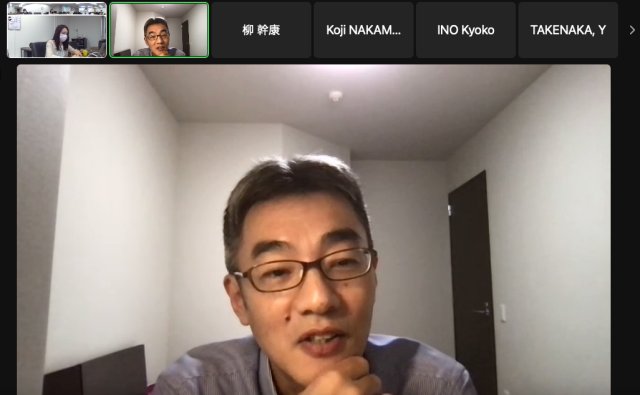The first research meeting of the Ushioda Initiative of Arts (UIA) was held on May 26, 2022. This meeting aimed to promote UIA, a new project launched this year. Since its inception, the EAA has been dedicated to promoting East Asian liberal arts. We use various methods to reestablish the connection between things, allowing us to integrate fragmented knowledge, departed thinking, and the body. Although this series is called “research meetings” (kenkyukai), the meetings are more akin to a salon. This is a space where anyone can speak freely and new discourse emerges. Mr. Yoichiro Ushioda (Honorary Member of EAA), other UIA members, and colleagues from both inside and outside of EAA attended this research meeting.

(From the left: NAKAJIMA Takahiro, Director of EAA. YANAGI Mikiyasu and TANAKA Yuki, IASA. WANG Muyun, EAA. TSUKAMOTO Maromitsu, IASA.)
YANAGI Mikiyasu (Associate Professor at Institute for Advanced Studies on Asia, The University of Tokyo) was the presenter and the topic was “The Formation and Development of Chan Buddhism in China: A Practical Theory as a Changing Life Form.” Chan thought and practice were developed in a highly mixed manner throughout history. The term “Chan” refers to an ancient Indian practice method known as dhyāna (jāna). In China, this practice was initially thought to be intended to grant supernatural powers. When Chan is combined with Taoist thoughts and practices, its interpretation of divine powers shifts from supernatural to natural daily behaviors, such as eating when hungry and sleeping when tired. However, Confucianism believes that this interpretation will lead to people adopting an overly casual lifestyle as a result of the lack of clear regulations. These criticisms, and the tensions they create, serve as the foundation for the development of Chan Buddhism.

(ISHII Tsuyoshi, Vice-director of EAA)
In the Q&A session, the feature of gathering in Chan cultivation was an important topic. As the saṃgha demonstrates, the fundamental practice of Buddhism always includes the concept of coexistence with (numerous) others. Only by coexisting with others and admitting one’s true nature can the Buddhist philosophy of living in the present moment and place become a practice. However, understanding Buddhist ideas is not always easy. The theory of coexisting with others while intervening and influencing them is unclear. Other challenges associated with this topic included defining “compassion” and assessing the elitism of Chan or religious communities.
Due to space constraints, it is difficult to cover all the topics and inspiring questions of this meeting in this report. We hope that these questions will prompt further discussion at future meetings.
Japanese Report by: SAKIHAMA Sana (EAA Project Assistant Professor)








